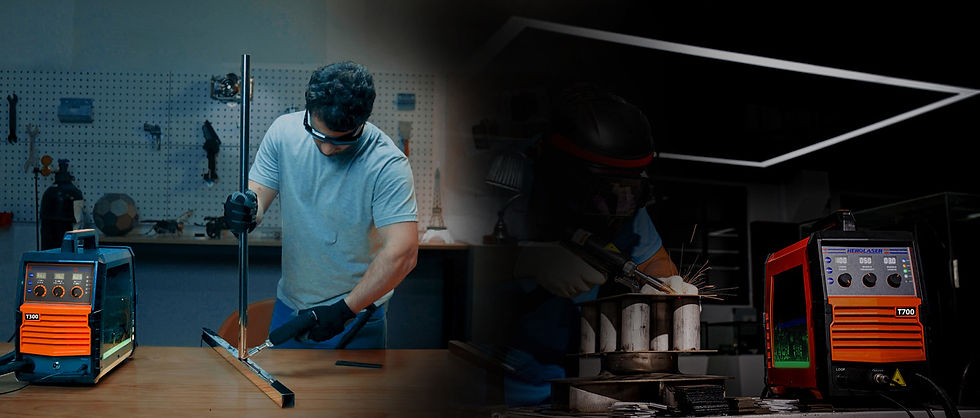Laser Welding: Revolutionizing Manufacturing with Unmatched Precision and Speed
- jims Mike
- Aug 6
- 3 min read

Laser welding has quietly revolutionized the way we join metals, transforming manufacturing workflows from the plant floor to high-tech labs. Unlike traditional arc or MIG/TIG welding, which rely on electric arcs or filler wires, laser welding employs a concentrated beam of light to melt and fuse metal surfaces. This precision-focused approach not only delivers cleaner welds with virtually no slag or spatter but also dramatically reduces heat-affected zones, minimizing warping and post-weld rework.
At its core, a laser welding system generates light—most often from a fiber laser source—and directs it through an optical fiber to a handheld torch or robotic arm. When this high-energy beam strikes the workpiece, it instantly vaporizes a tiny spot, forming a keyhole that allows deep penetration with a very narrow weld seam. Operators can adjust power levels, pulse duration, and travel speed to accommodate materials ranging from thin aluminum panels to thick steel plates, giving unprecedented flexibility across industries.
In automotive manufacturing, laser welding has become a game-changer. Carmakers use it to assemble body-in-white structures, joining door skins, roof panels, and chassis components at line speeds that would overwhelm conventional welders. The speed advantage is remarkable: laser welders can operate up to ten times faster than arc welding, slashing cycle times and boosting throughput. Moreover, the narrow seams require little to no grinding or finishing, which not only saves labor but also enhances the cars’ fit-and-finish quality.
The aerospace sector similarly benefits from laser welding’s precision and strength. Aircraft components often involve exotic alloys like titanium or nickel-based superalloys, which demand tight control over heat input to preserve material properties. Laser welding delivers clean, high-integrity joints without filler materials, reducing both weight and potential points of failure. Whether manufacturing turbine blades, landing gear parts, or fuselage panels, aerospace engineers increasingly turn to laser systems for their unmatched consistency.

Beyond large-scale production, laser welding also excels in on-site repair and maintenance. Portable laser machines allow technicians to address cracks, corrosion damage, or equipment failures directly in the field—without dismantling heavy machinery. Shipyards, power plants, and oil rigs use handheld laser welders to restore critical components quickly, minimizing downtime and avoiding costly transport to off-site workshops.
Yet the story doesn’t end with today’s applications. The future of laser welding is poised for even greater leaps forward. Emerging ultra-high-power fiber lasers—capable of delivering over 10 kW—will open new doors in welding thick structural parts, bridging the gap between laser and traditional arc processes. Hybrid laser-arc systems, which combine the deep penetration of lasers with the gap-bridging prowess of arc welding, promise enhanced adaptability for complex joint geometries and larger tolerances.
Artificial intelligence and machine vision are also on the horizon. By integrating real-time seam tracking and adaptive power control, next-generation machines will automatically adjust parameters to maintain perfect weld quality, even on parts with variable shapes or surface conditions. This level of automation not only reduces the need for highly skilled operators but also ensures zero-defect production—crucial for industries like medical device manufacturing or electronics assembly.
Sustainability is another compelling driver. Laser welding’s energy efficiency often exceeds 30 percent—far higher than most welding processes—translating to lower power consumption and reduced carbon footprints. Additionally, because lasers eliminate or minimize the need for consumables like filler wire, flux, and shielding gas, they generate less waste and cut down on material costs.

As businesses worldwide embrace lean manufacturing and Industry 4.0 principles, laser welding stands out as a linchpin technology. Its blend of speed, precision, and versatility meets the demands of modern production, from mass-market automotive lines to bespoke high-tech components. For engineers, fabricators, and maintenance teams alike, laser welding offers a powerful toolset to streamline workflows, enhance product quality, and push the boundaries of what’s possible with metal.
In short, laser welding is more than just a step forward—it’s a leap into a future where metal joining is faster, cleaner, and smarter than ever before. Whether you’re building the next generation of electric vehicles, crafting life-saving medical implants, or keeping industrial equipment running smoothly, laser welding technology has become indispensable, and its best innovations are still yet to come.



Comments